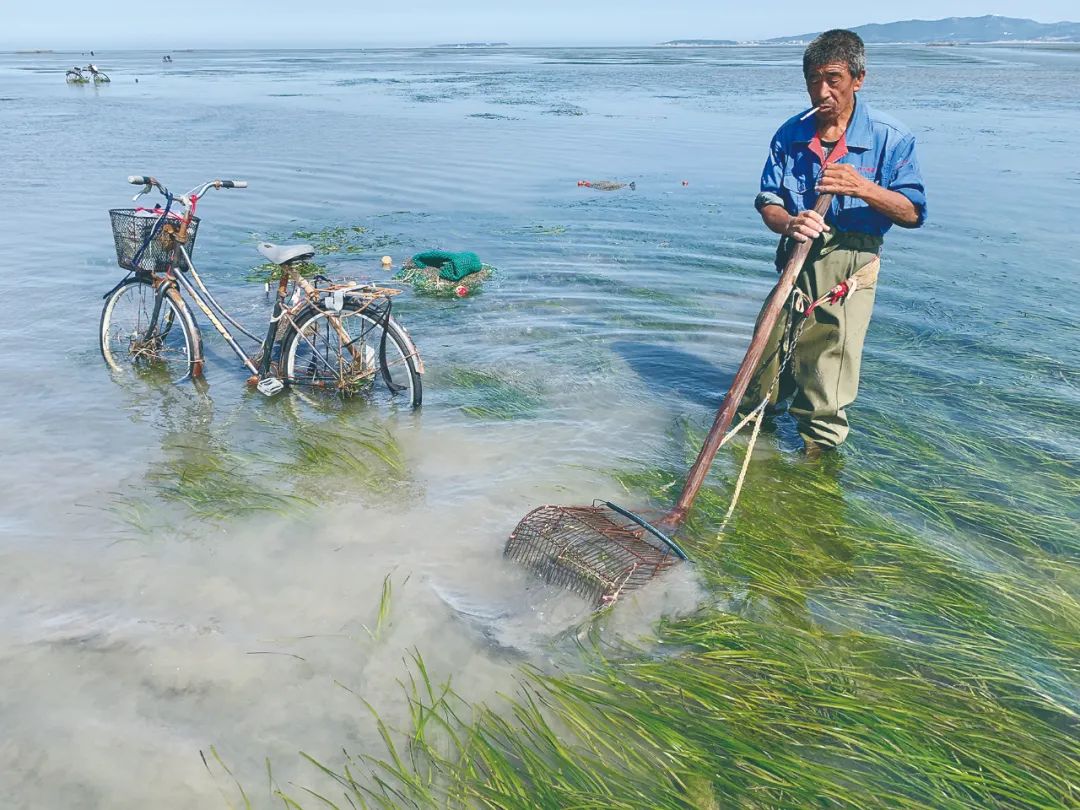Over 80%of the seaweed beds in my country disappear!Protecting the "lung of the ocean" is urgent
Author:Journal of China Science Time:2022.09.15
Text | Zhou Yi (Researcher of the Institute of Marine Institute of the Chinese Academy of Sciences)
Earlier this year, the national science and technology basic work "my country Important Sea Resources and Habitat Survey" conference was held in Beijing.
This indicates that my country has mastered the information of the nation's coastal seagrass resources, and has taken a solid step towards the protection and repair direction of seagrass beds.

Humans dug clams to destroy Hulu Island Seawear bed. Map of the Ocean
Seaweed is not seaweed
Sea and grass originated from land quilt plants. It is the only category on the earth that can live completely in seawater. Compared with the high -land high plants, it is extremely scarce. 4 family 9 genus 16 species.
Except for Antarctica, seagrass is distributed in the waters of the world. It usually grows in the shallow sea and the river mouth waters. From the tide to the tide belt, the maximum water depth can reach 90 meters.
There are 6 major global seagrass distribution zones, including tropical India -Pacific, tropical Atlantic zone, temperate North Pacific region, temperate North Atlantic zone, Mediterranean and temperate South Ocean.
The seawweed distribution zone in my country is divided into two regions: the seas distribution area and the tropical -subtropical seagrass distribution area. Among them, the seas of the temperate waters includes Shandong, Hebei, Tianjin, and the coast of Liaoning. , Hong Kong, Taiwan and Fujian coast.
The difference between seaweed and seaweed is very different. As a high plant, seagrass has the differentiation of root, stems, and leaves, and the root system is complicated. It can be fixed in sediments and extract nutrients and minerals.
And seagrass can be sexually reproduced by flowering, flour passes, and concluded, or asexual reproduction through the rhizome.
The seaweed is a low -class plant, and there is no differentiation of root, stems, and leaves. Some seaweed (such as kelp) has a pseudo -shaped fixing device and can be simply fixed on the hard matrix, such as rocks or shells, and seaweed can only pass through through. Spories breeding.
In addition, seagrass performs photosynthesis through leaf cells, and all cells of seaweed can perform photosynthesis; seagrass can transport minerals and nutrients through ventilation tissue and cavity (leaf veins). substance.
In the past, seagrass was often named after the word "algae", which was easy to make people misunderstand seaweed and cause confusion. Therefore, in November 2014, when the "11th International Seal Biology Symposium" was held in China, domestic seagrass research experts discussed and unified the segments of 3 families and 7 genus and 7 genus and 7 genus. Named "grass", which has brought convenience to the research and popular science of Chinese seagrass, and promoted the protection and management of Chinese seagrass beds.
Seaweed bed is an important marine fishing ground and carbon storage
Seaweed bed refers to the three typical offshore marine ecosystems led by a single or various seagrass plants, and mangroves and coral reefs. The lungs "" underwater grassland "and" underwater forest ".
Seaweed bed is an important marine fishing ground. It can provide various marine creatures with habitats, places for childcare, and shelter. It is an important source of food for organisms such as dugcles, green turtles and water pows. The lush seaweed has a large number of marine creatures such as fish and crustaceans, and also provides tens of thousands of large swans to provide overwintering habitats and food sources. Among them, more than 60%of the food intake of large swans comes from seagrass leaves.
At the same time, seaweed beds are one of the most effective carbon capture and sealing systems on the earth. Its efficiency of storage of carbon storage is 90 times higher than forests and is an important global carbon bank. Although the seaweed bed only covers 0.2%of the global maritime area, its annual carbon sealing amount can reach 10%to 15%of the total global marine carbon seal, and the carbon storage time can reach thousands of years. Therefore Change has an important role.
The high -efficiency carbon capacity of seaweed beds benefits from its high productivity, strong suspension capture capabilities, and high stability of organic carbon in seagrass sediments. First of all, 15%to 28%of the annual production of seagrass beds are buried on the bottom of the sea for a long time, and the contribution of organic carbon storage to sea grass beds is about 50%. Second, the seaweed crown can efficiently capture a large number of organic suspended particles in the water body, thereby achieving solidification Carbon; Finally, the organic carbon fixed in the sedimentation of hypoxic seaweed beds has a relatively low decomposition rate and high stability.
In addition, seagrass can regulate suspension, dissolved oxygen, heavy metals and nutrient salts in the water body, and play a role in purifying the water quality. It can also reduce the energy of waves and water flow through the blocking effect of slender blades. At the same time, the dense root system of seaweed can curing the bottom quality to prevent or slow the loss and erosion of the beach and coast.
According to rough statistics, taking the largest seagrass bed in my country, Tangshan Sea Grass bed (3217 hectares) as an example, it can support 240 million tails of fish and 300 billion vertebrates, which can fix 12,000 to 21,000 tons of carbon dioxide each year. Every year, it can be fixed. The nutritional salt (3.6 tons) that can absorb 600,000 people's domestic sewage can release 300 million liters of oxygen per year, and its evaluation value is $ 120 million per year.
Over 80%of my country's seaweed beds have disappeared
With the increasing intensity of ocean development and utilization, marine ecological environment and biological resources are facing serious threats, and the seaweed beds in my country have severely degraded.
The direct causes of degradation of seaweed beds in my country include habitat loss and destruction, mechanical destruction of seagrass, decreased water body transparency, and water temperature exceeding the tolerance limit of seagrass.
At present, the main threats facing my country's seagrass include coastal engineering construction and encryption activities, land source pollution, fishery activities, large algae outbreaks, mutual flower rice grass invasion, climate warming, and typhoon. According to the latest census results (2015-2020), the area of seaweed beds in my country is about 26495.69 hectares, and the 4 genera of seagrass is 16.
Compared with historical distribution and types, it was found that 6 kinds of seagrass, including wide -leaf eel, stem eel, black fiber shrimp, full wedge grass, hair leaf like salt grass, and Daguchuan vine grass have disappeared. 80%of the seaweed bed has disappeared.
For example, in 1982, there were more than 1,300 hectares of eel grass community distributed near the Furong Island of Laizhou Bay, but now it is not seen; from 2015 to 2021, more than 1,000 hectares of Japanese eel beds were typhoon (2019) and The invasion of Mutual flowers and grass has disappeared; in the past 8 years, the coastal coastal coastal seagrass distribution area was enclosed and transformed into a port terminal land and real estate land, which has caused permanent loss of 354 hectares of seagrass habitats.
Protection and repair dual -pronged approach
In recent years, the international community has gradually realized the importance of seaweed beds, and the protection and recovery of sea grass beds have gradually become one of the international research hotspots.
In terms of the protection of seagrass beds, first of all, the seaweed protection management system should be established as soon as possible, and the management regulations on the protection of sea grass beds should be formulated, and the protection of seagrass protection will move to the regularization and legalization of seagrass, and to prohibit the direct damage of seagrass beds such as encryption.
Secondly, the seawweed bed protection area is reasonably planned, and 6-8 national seagrass bed nature reserves are recommended. As of now, only two provincial -level seagrass bed protection places in China -Lingshui New Village Port and Li'an Port Sea Grass Special Reserve and Tangshan Sea Grass bed natural protection areas in Hainan Province.
Third, establish a seagrass bed life monitoring system, scientifically manage and protect the seagrass bed, and it is recommended to establish 1-2 national -level seaweed bed wild ecological monitoring and research stations.
In addition, it is necessary to control the discharge of pollutants to improve the quality of life of seagrass beds; scientific management and development of seaweed bed fishery resources, encourage and guide the development of marine pastures and preparation industries based on the construction of seagrass beds, and strengthen the planning and construction of the ecological tourism area of seaweed beds; Strengthen the scientific research of seaweed beds to improve the protection of seagrass resources; popularize the ecological value of seaweed beds, strengthen the publicity of the knowledge of seagrass bed through multiple channels, and increase the awareness of seagrass protection.
In terms of the restoration of the sea grass bed, the ecological restoration and reconstruction of the seaweed bed should be strengthened, the ecological restoration project of the sea grass bed should be implemented, and the underwater forest should be restored.
Strengthen the scientific research of seaweed beds and improve the ability of seagrass resources. In particular, we must concentrate on the development of high -efficiency seaweed bed ecological restoration of the degradation of seaweed beds and the characteristics of habitats in my country.
With the deepening of research, the protection and restoration of seaweed beds will gradually become a kind of environmental protection public welfare action for the whole people. I believe that in the near future, just like "planting trees and afforestation", everyone can participate in the protection and repair process of seagrass.
"China Science News" (2022-09-15 The first edition of the original title "Ocean's" lungs of the country must be taken care of ")
not
Edit | Zhao Lu
Capture | Guo Gang

- END -
Speed at the end: China's self -driving driving fastest 1000 days

Jia Haonan sent from the Gafei TempleQuantum position | Public account QBITAI1000 ...
Stir the spring water in the e -commerce industry, and the vibrato quickly make up for the logistics short board

[Dahe Daily · Dahecai Cube] (Reporter Ding Yangtao) When you surf the softened th...